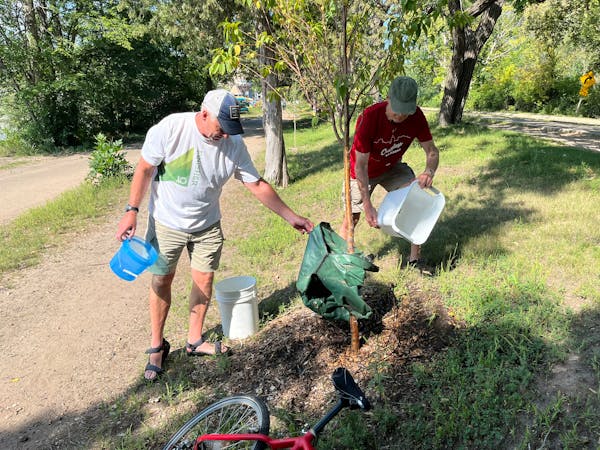Vern Simula wanted the story of his life to end where it began. In the earth of Carlton County.
Simula, 90, was born in Cloquet and generations of his family rest in a local cemetery. But when he tried to make his own arrangements, the cemetery turned him away.
Simula wants a green burial. No embalming. No glossy coffins with satin pillows. No makeup on his cheeks to create the illusion of life. Just a grave, a shroud and a return to the earth.
"My body is a temple, with its [30] trillion cells," said Simula, a longtime advocate for green burials. "Those cells are valuable to creation. I don't want them pickled with formaldehyde and I don't want them incinerated in a waste of fossil fuels."
Not every cemetery welcomes a green burial, but Simula thought he had found a new resting place — a new green cemetery was set to open in Carlton County. But a battle between the cemetery and its uncomfortable neighbors spiraled into a ban that will stop any new green cemeteries from opening in Minnesota for the next two years.
Individual green burials will continue — the practice is central to many faiths. But two years is a long time to ask Vern Simula to wait for the state to study humanity's oldest burial practice.
When his hometown cemetery turned him away, Simula made arrangements to be buried instead at Fort Snelling National Cemetery, which accommodates green burials, particularly for Jewish and Muslim veterans.
Then came plans for a new green cemetery right in Carlton County, in beautiful Blackhoof Township.
A 20-acre hayfield was going to be converted into the Loving Earth Memorial Gardens. There would be trees and wildflowers and walking paths. People would be buried in plain pine boxes or biodegradable wicker coffins or simple shrouds. There would be no marble headstones and manicured lawns and no concrete grave liners to stop the earth from sagging as the coffins decayed. Families would be invited to walk the trails and pick blueberries from the bushes they planted over their loved one's grave.
That was what Matt Connell pictured when he bought the site and filed his paperwork with the county.
"It never crossed my mind that people would be angry over it," said Connell, who lives in Crystal and teamed up with the New Jersey-based Steelmantown Cemetery Co. to start the business. "I was naïve. I thought people would really like this."
But where Connell saw a peaceful park, some neighbors saw a nightmare.
Strangers' bodies in unmarked graves they could see from their kitchen windows. What if coyotes dug someone up? What if the cemetery contaminated nearby wetlands or wells? Would it spread disease? Would it crowd the roads with traffic? Would it change the character of the entire community?
As residents circulated petitions and spoke out against the plan at public meetings, county officials drafted new cemetery regulations and declined to register the cemetery plat.
And then the Minnesota Legislature got involved.
The Minnesota Senate Health and Human Services Committee held a hearing on green burials in March and a bipartisan cross-section of state lawmakers did not like what they heard. A two-year moratorium on new green cemeteries was tucked into one of the end-of-session spending bills, with with orders for the Department of Health to investigate. The study will cost taxpayers an estimated $79,000.
The idea of a green burial can seem distasteful and even disrespectful in a country accustomed to a more sanitized view of death. It's been generations since we washed the bodies of our dead ourselves and laid them out in the parlor with pennies on their eyelids.
"It's very different than what we're used to," said Dr. Rebecca Wurtz, director of the Public Health Administration and Policy program at the University of Minnesota. "But it's what was done for hundreds of thousands of years. ... Certain religions feel very strongly that this is exactly the way someone should be buried."
Dead bodies and green burials are not a threat to public health.
There are only a handful of infectious diseases that can be spread from dead bodies to the living, Wurtz said — cholera, anthrax, ebola. The rest of the 39 trillion microbes we each carry — viruses, bacteria, fungi — decay with us into the soil.
Allison Ronning, who lives in the nearby town of Kerrick, is an end-of-life doula — helping families through the process of death. A green burial would be her choice. If state lawmakers had given her a choice.
"I told my family, 'This is the way I want to go,'" she said. A good death is a gift, she said, and we only get one shot at it.
Simula, who will be 92 by the time the study concludes, has gathered 300 signatures on a petition asking the Health Department to hurry up.
Connell says he has already turned grieving families away.
"Which kind of breaks my heart," he said. "I hope that all of us, opponents and proponents alike, will be friends one day. And we'll all have a laugh about it, and we'll all be looking out at this beautiful arboretum cemetery and sharing in its beauty."
Brooks: After insulting Jennifer Aniston and 'childless cat ladies' everywhere, JD Vance heads to Minnesota
Brooks: One heartbeat away from making Kamala Harris' search for a running mate all about Minnesota

Brooks: Don't cry because it's Joever; smile because I'm about to tell you my incredibly wholesome Naked Joe Biden story

Brooks: The VA wants your help picking a name for a new clinic for female veterans



